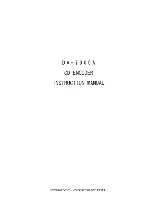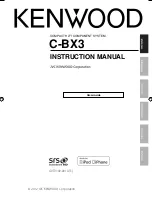
31
arc.. Then the torch is released to terminate the arc and begin post
flow.
Shielding Gas. Shielding Gas is necessary while TIG welding. The
shielding gas used for the TIG process is 100% Argon. Shielding
gas protects the weld from oxidation by the atmosphere while the
weld puddle is still molten. Gas flow rates are controlled by the sup-
plied regulator. Too little gas flow will cause porosity, heavy scale
and or oxidation. Too much gas flow is wasteful and can also create
a turbulent flow, which can pull the atmosphere into the weld, creat-
ing oxidation.
Start Amps. This is the initial Amperage of the weld in TIG mode.
This is the starting point, at which the arc initiates. The Start Amps
are sometimes referred to as
“
Hot Start
”.
For this unit, the start Amps
have been fixed at the minimum value
Stick. In North America, this is the SMAW process (Shielded Metal
Arc Welding) In other regions this is called MMA (Manual Metal Arc).
Stick is an older term to refer to the stick like appearance of the weld-
ing electrodes (also known as welding rods). This is a versatile pro-
Component Identification and Explanation
Explanation of Functions and Welding Terms
been preset at a 50% value to offer an even balanced feel.
AC Pulse TIG operation is setup the same. Do not confuse AC cy-
cling between EP and EN as pulse. It is not. You are still adjusting
the amperage of the AC pulse, and skewing the balance and chang-
ing the frequency similarly to the DC pulse.
Regulator. Controls the flow rate of the shielding gas at the cylinder.
Remote. Remote refers to the ability to control the weld cycle at a
distance. For this welder, all forms of TIG welding, whether with Lift
Start or High Frequency Start, require a remote to operate. A remote
can be a foot pedal, torch switch, or torch mounted slider or Amptrol.
All three start and end the arc as well as control other parts of the
weld cycle to varying extents. The unit has three Remote settings to
choose from. The first two, 2T and 4T, deal exclusively with torch
switch operation. The third is pedal control.
Pedal mode is the most straight forward. Operation is quite simple.
The maximum amperage is set on the panel. Then the foot pedal is
used to start and stop the arc as well as vary the amperage from the
minimum welding setting, up to the maximum welding setting select-
ed on the panel. Down Slope should remain zeroed out, or set at the
minimum allowed setting.
2T mode and 4T mode offer two modes used with the torch switch
that is included with the TIG torch. This is used to control the torch
cycle through functions of Pre/Post Flow, Up/Down Slope, Start/End
Amps. (Though this unit may not allow all of these functions to be
adjusted, they are still present in the function and have been preset
for best operation) In 2T mode, the torch switch is simply pressed
and held to start the arc and cycle the preprogrammed settings.
Once arc termination is desired, the switch is released. In 4T mode,
the Torch trigger is held down to start the pre
-
flow and initiate the
arc. The switch is then released and the unit begins up
-
slope until it
reaches the welding current. The weld is continued without the
switch being pressed. Once the weld is nearing finish, the torch
switch is once again pressed and held to down slope to tail off the
NOTICE:
While using the foot pedal, and the optional slider switch, the weld-
er
’
s digital display will revert back to the minimum amp setting on the
welder after the arc is terminated and it will not display maximum set
amps. It will only display maximum set amps while the unit is being
adjusted for amperage. While welding the display will read actual
weld amperage. After 3
-
4 seconds the display will default back to the
minimum amp reading. When using 2T or 4T control modes, the
amps will register the maximum set amps until the arc is started. To
see the maximum set amperage in the pedal mode without the arc
on, simply make a small adjustment in the main adjustment knob
while the Welding Amps light is lit. The unit will revert to the
“
setting
”
mode and display selected maximum amperage.
How Does 2T and 4T Work?
The torch switch has two possible modes of operation. The first is a
“
press and hold
”.
The second allows the switch to be released to
weld, but offers separate motions to start and stop the arc. See below
for how each function is activated by movements of the torch switch.
2T Torch Operation Effect on Weld Cycle.
4T Torch Operation Effect on Weld Cycle.
PREFLOW
POST FLOW
=
UP ON SWITCH
=
DOWN ON SWITCH
WELD AMPS
WELD AMPS
PREFLOW
WELD AMPS
POST FLOW
START AMPS
START AMPS
END AMPS
END AMPS
How Do I Start an Arc With Stick?
There are two basic types of arc starting methods used. The tapping
motion allows pin point placement of the arc, while the scratch start
method is similar to a match strike and is easier for beginners.
Tapping
Scratch/Match Method
Содержание PowerPro 164Si
Страница 46: ...46...
















































